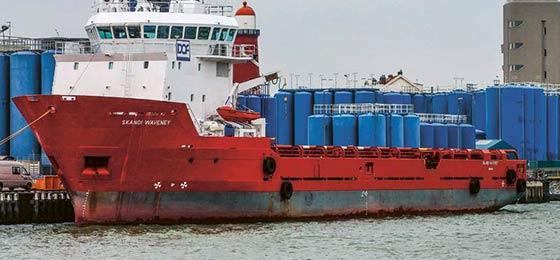Turning CO2 into something sensible

A research team from ETH Zurich is developing new types of catalyst that can turn carbon dioxide gas into a storable, liquid resource. We've taken a peek at their laboratory. By Dölf Barben
(From "Horizons" no. 114 September 2017)
Kabel,We're in a laboratory of the Department of Mechanical and Process Engineering at ETH Zurich face to face with cables, containers and gas flasks, all rather small and not at all impressive. Before our visit, Professor Philipp Rudolf von Rohr had promised us that we'd be seeing a "real research facility". But standing in front of us, atop a chest of drawers, is just a block of metal with a small window in it. We're told it's actually a viewing cell in a catalytic reactor. When used together with a Raman spectrometer, the reactor enables the researchers to observe material properties down to the molecular level. The interactions between the light of the laser beam and the material inside the reactor produce the signals that interest experts.
Now, at least, it's obvious that the size of the test setup is inversely proportional to the importance of the project, which is the joint effort of Philipp Rudolf von Rohr and over a dozen researchers from eight countries. "Our goal is to turn CO2 into something sensible", says Rudolf von Rohr.
This isn't about getting carbon dioxide from the air around us – though it does have to do with our climate. They want to make it possible to turn CO2 into a liquid resource. Using hydrogen, they want to turn this harmful greenhouse gas into a commodity from which they can in turn produce useful things such as fuels. The problem with storing CO2 as a gas is that it requires a gigantic effort. But if it can be turned into a liquid, it can be stored and transported with ease.
Tricky catalysts
On paper, the problem looks simple enough for schoolkids to solve. And the research team has already mastered two of the three necessary steps involved. First, two catalysts are used to transform the gases carbon dioxide (CO2) and hydrogen (H2) into formic acid and methanol, which then unite to form methyl formate. Then another catalyst is used to break down this intermediary product into formic acid and methanol again, this time as liquids. The tricky one is the first catalyst used to produce formic acid, or, to be more precise, its interaction with the second catalyst that produces the methanol. Rudolf von Rohr and his team are experimenting with pressure, temperature, retention time, volume, yield, and much, much more. Last but not least, the researchers are faced with the problem of being able to identify reliably everything that emerges, whether by design or not.
What's more, their desired product, formic acid, is also proving to be wayward. There is no simple method for determining what volumes emerge after a reaction. "Measuring it is not at all simple", says Rudolf von Rohr, who clearly knows innumerable ways of avoiding the concept of 'highly complicated'.
Rudolf von Rohr's team comprises chemical and process engineers, but they don't work on their own. "Problems like this can only be solved when different disciplines work together", he says. There are four groups of researchers busy with it: specialists in catalysts, then analysts who can determine "what actually comes out at the other end", as Rudolf von Rohr says. Then there are the chemists who are trying to understand what exactly happens with the catalyst. And, finally, there is Rudolf von Rohr's own group, which is building, running and optimising the apparatus. It wouldn't work without an interdisciplinary approach, he says.
Towards a CO2-neutral energy cycle
"This research project is worthy of support, not least because it points us in the direction of a CO2-neutral energy cycle", explains the physicist Reto Holzner. He's the head of development at Silent-Power, a company that markets electricity generators that run on ethanol. In the light of climate change, developments towards this goal of a CO2-neutral energy cycle are among the most important of all, he says. He sees possible difficulties in the multiple catalysts, while the high pressure involved could become a problem in later, bigger plants. But their findings are ultimately of great importance for Switzerland as a business location, says Holzner. "Otherwise, others will overtake us".
Dölf Barben is a journalist at the daily newspaper Der Bund.